Mark Twain’s Baseball Town
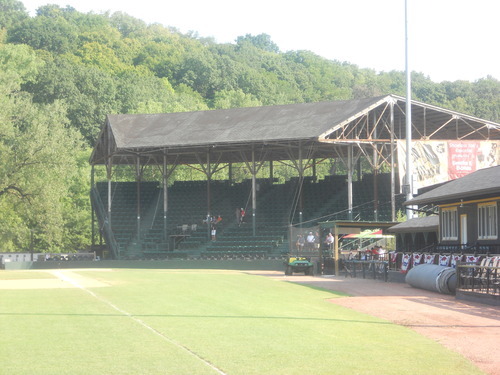
July 19, 2012—
HANNIBAL, Mo.—-The sleepy but spunky Hannibal, Missouri was built on escapism. Situated on the west bank of the Mississippi River along majestic limestone bluffs and caves, the town’s endless gateways caught the imagination of a young Samuel Clemens. Freight trains still run by the Mississippi River and Bear Creek and they, too have always been on their way to someplace bigger.
Like Dubuque.
On this humid Sunday evening in mid-July, Danville Dans assistant coach Trevor Hall would rather be anywhere than the historic Clemens Stadium on the south edge of downtown Hannibal (pop. 17,880).
In the third inning of the Prospect League matchup against the Hannibal Cavemen, the Dans loaded the bases with no outs and failed to score. Players sat on beige lawn chairs in open air dugouts. After Zane Dillon popped to first to end the inning Hall chucked a couple of lawn chairs to no one in particular.
In the bottom of the eight Dillon was up again.
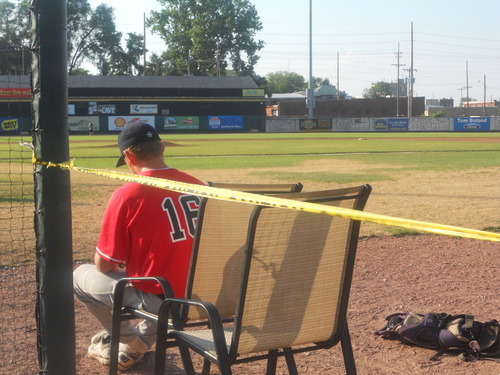
Hannibal was winning 5-3, but the Dans were mounting a threat. The Dans had runners on first and third with one out. A squeeze was on. Dillon’s bunt was popped up and caught by Cavemens third baseman Ryan Light who beat the Dans runner back to third for an unassisted double play. The stereo groans of Hall and his manager Jamie Sailors (good name for a river town) could be heard in the grandstands.
But then the paid attendance was announced at 1,026.
I believe the crowd was less than that, and of course Samuel Clemens was known to embellish the truth.
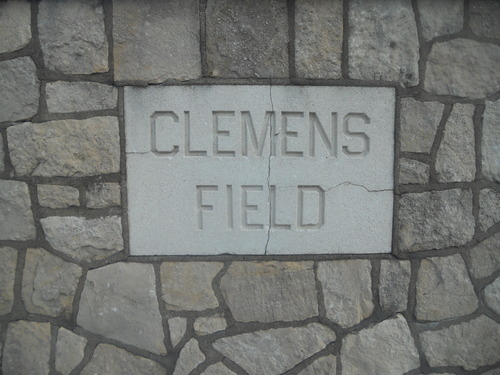
Clemens Field was built in 1937 as a WPA (Works Progress Administration) project. The ballpark was constructed on a former lumber yard, next to the Norfolk & Southern train tracks. Freight trains still roll by two or three times during a game and kids shag foul balls by the train tracks during the game. I have been to hundreds of baseball stadiums and have never seen train tracks so close to the field.
“In 1944 the stadium was a POW camp,” said historian Ken Marks, who operates the Hannibal History Museum (and Haunted House Tours) with his wife Lisa. “It was a camp for less than two months, but Germans were always kept in the middle of the U.S. A couple hundred prisoners were here. The idea was to provide free labor for the International Shoe Company which was here. We were making army issue boots and the Germans were our testers.”
There may not be a better place (well maybe Clinton, Iowa) within driving distance of Chicago to absorb the dreams of baseball, in this case a college summer league.
Young players run between country ghosts.
Mark Twain wrote of his beloved Mississippi River, “Sometimes on the water you can see a spark or two.”
And this is very true of potential stars at Clemens Stadium, even though the Dans lost 6-3 on a parched red clay field made worse by 87 degree temperatures during the night game.
Don’t waste any time. The Cavemen’s home season ends Aug. 6 against the Quincy Gems. Hannibal is just a four and a half drive from Chicago, I-55 (or Route 66) to Springfield, then cut west on I-72 to the Mississippi River. Just beautiful.
Twain was a baseball fan. After leaving Hannibal he began following the Hartford (Ct.) Dark Blues in 1874. In March, 2010 the New York Times printed a photo of a primitive 1907 scorecard on a notebook that Twain kept while watching the Dark Blues play the Boston Red Stockings.
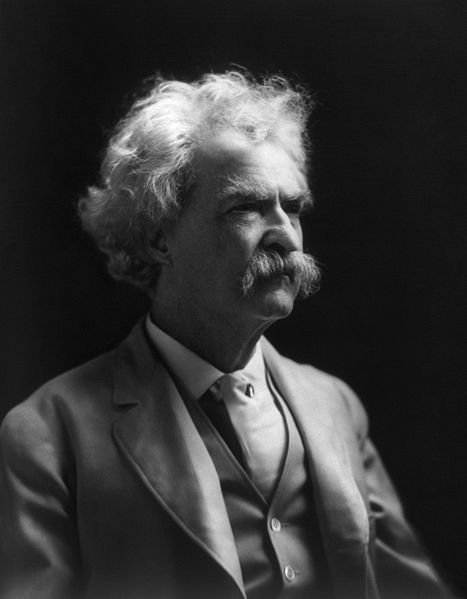
Mark Twain, the ol’ 6-4-3 in 1909.
And in 1889’s “A Connecticut Yankee in King Arthur’s Court,” Twain wrote, “My peerless short stop! I’ve seen him catch a daisy-cutter in his teeth!”
Today’s editors would send you to rehab for writing like that.
Hannibal spent 1952-56 in the Mississippi-Ohio Valley League, the precursor to the Midwest League. The franchise was transferred to Michigan City, Ind. before the 1956 season. In 1953-54 they were known as the Hannibal Cardinals due to their affiliation with St. Louis. In 1954 future Cleveland Indians slugger Leon “Daddy Wags” Wagner led the league in hits with 160 for Danville while Hannibal’s player-manager J.C. Dunn hit 26 home runs to lead the circuit.
But nothing beats the team name the Hannibal Cannibals, who existed around 1910, the year Twain flew away on Halley’s Comet.
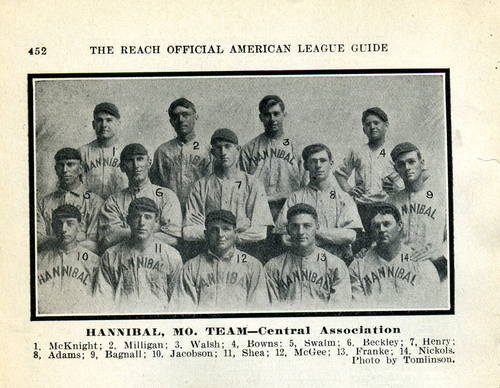
1909 Hannibal Cannibals, courtesy of Ken Marks
The 1911 Cannibals finished 45-81 in last place in the 8-team Class D Central Association that also included the Burlington Cow Boys and Muscatine Camels. The 1911 Cannibals were managed by Jake “Eagle Eye” Beckley, Hannibal’s most prominent sports export and a member of the Baseball Hall of Fame.
Hannibal’s present day mascot is “Shoeless Joe from Hannibal Mo.,” and his big black bushy eyebrows and muscular shoulders made me think he probably was a caveman. Or he could be a cannibal.
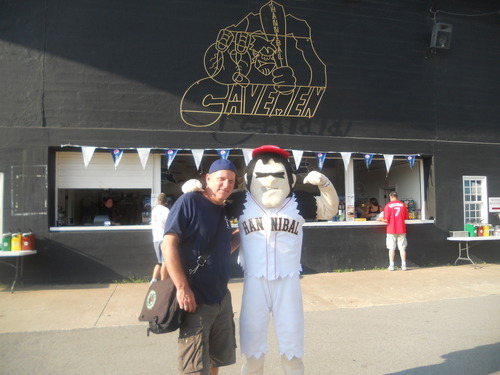
One manly man, one geeky fan.
Fans cluster under one large steel and wood grandstand behind home plate. There is no press box and certainly no sky boxes. The official scorer and any press sit next to the Cavemen’s dugout down the third base line. I bogarted a lawn chair in the evening sun adjacent to the Dans dugout.
After a 2009 multimillion dollar renovation, baseball returned to Hannibal. That same year Clemens Field was designated a Federal and State Historic Landmark. The team is owned by Bob Hemond, the son of Bill Vecck buddy and Arizona Diamondbacks executive Roland Hemond. Bob Hemond is also Executive Vice-President and minority owner of Class AAA Sacramento River Cats. He lives in California.
I stayed the night at the Best Western, the only motel in Hannibal. I ran into the beleaguered Dans in the hallway after the game. The next morning I visited the one year-old Hannibal History Museum, 217 N. Main St., where the passionate Marks gave me directions to the Beckley burial spot high atop the bluff of Riverside Cemetery, not far from Clemens Stadium.
Do not miss visiting the museum, located in a beautiful brick and pressed tin exterior building. The 1897 building once was a cigar factory on the first floor and sewing machine factory on the second floor. A small portion of the museum is devoted to Beckley.
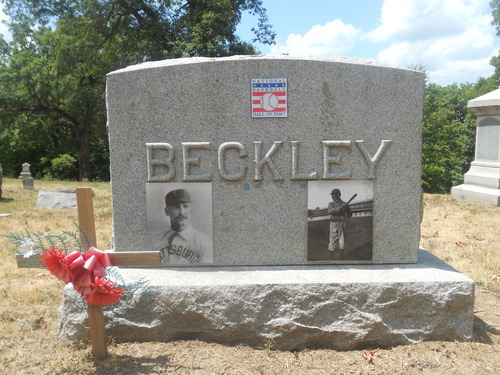
Beckley was inducted into the Baseball Hall of Fame in 1971. He began his pro career in 1891 with the Pittsburgh Alleghenys/Pirates and retired after the 1907 season with the St. Louis Cardinals. The first baseman had 2,930 hits at the time of his retirement, second only to Cap Anson at the time. A lifetime .308 hitter, Beckley held the career record for games played at first base until 1994 when he was passed by Eddie Murray.
Beckley had one slightly crossed eye. He also was apparently influenced by the poetic air of Hannibal. According to a David Fieitz’s essay for SABR, Beckley liked to yell “CHICKAZOOLA!” to rattle opposing pitchers.
After retirement, Ol’ Eagle Eye was an umpire in the Federal League.
Beckley died of heart disease in 1918 at the age of 50.
I picked up the double CD “Mark Twain Words & Music” for my drive back to Chicago. The project benefits the Mark Twain Boyhood Home & Museum in Hannibal. The CD features Clint Eastwood as Twain, Jimmy Buffett as Huck Finn and Garrison Keillor is narrator. Music by Sheryl Crow (a killer version of “Beautiful Dreamer”), Emmylou Harris and others are edited within the spoken words.
Many passages caught my ear, but I smiled aloud when Eastwood as Twain read: “High and fine literature is wine, and mine is only water; but everybody likes water.”
And that’s why I liked Hannibal.

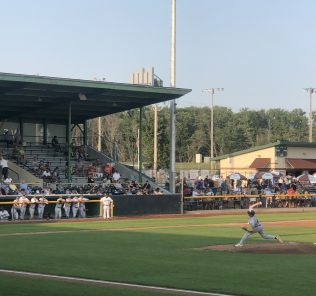



Leave a Response